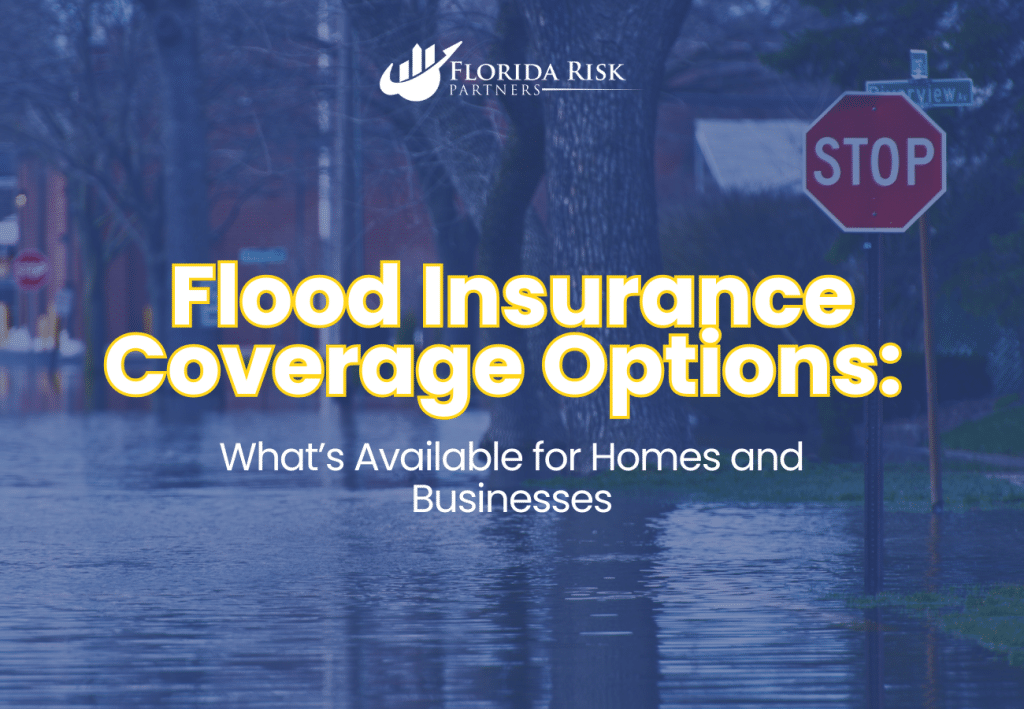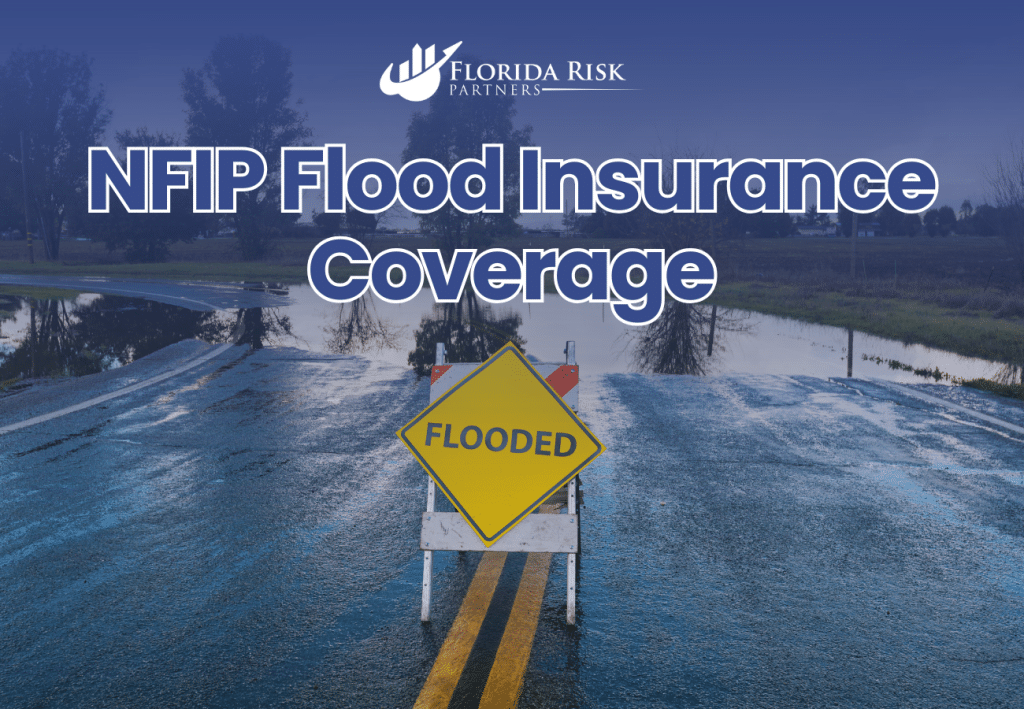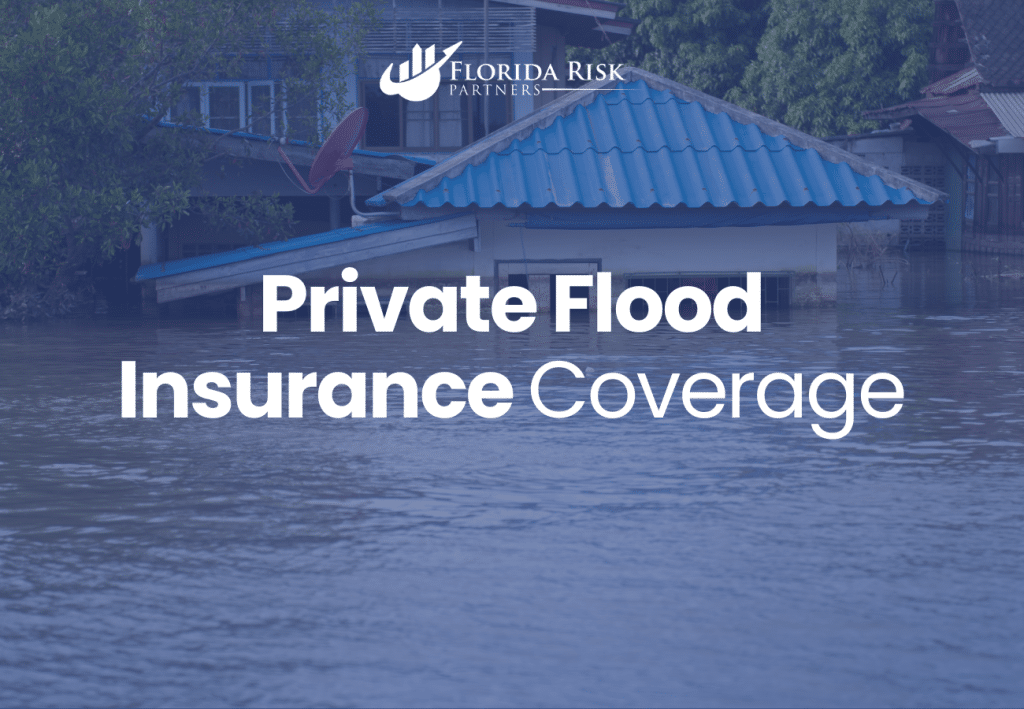-
Main Office: 1434 E. Bloomingdale Ave Valrico, FL 33596-6110
-
Phone: (888) 601-6660
-
Email: info@floridariskpartners.com

Flooding can happen almost anywhere, whether you live in a high-risk coastal area or a low-risk inland region. With floods being one of the most common and costly natural disasters, having the right flood insurance is crucial for protecting your home or business. But not all flood insurance policies are created equal—different coverage options are available depending on your property type and needs.
In this blog post, we’ll explore the flood insurance coverage options available for homeowners and business owners, including the types of coverage, the limits provided by the National Flood Insurance Program (NFIP), and the additional protection offered by private insurers. Understanding your coverage options will help ensure that you have the right policy in place before disaster strikes. This post is part of our Flood Insurance 101 series, designed to help you make informed decisions about protecting your property.
The Basics of Flood Insurance Coverage
Flood insurance is designed to cover losses directly caused by flooding, which is defined by FEMA as “a general and temporary condition of partial or complete inundation of two or more acres of normally dry land or of two or more properties.” It’s important to note that homeowners insurance and business property insurance typically do not cover flood damage, so a separate policy is required.
There are two main components of flood insurance coverage:
- Building Coverage: Protects the physical structure of your home or business, including walls, floors, foundations, plumbing, and electrical systems.
- Contents Coverage: Protects your personal belongings, such as furniture, electronics, clothing, and business inventory.
Flood insurance is available through the NFIP and private flood insurance providers. Let’s take a closer look at what each option offers.
NFIP Flood Insurance Coverage
The National Flood Insurance Program (NFIP) is the primary source of flood insurance for homeowners, renters, and businesses in the U.S. The NFIP provides standardized coverage options with set limits on building and contents protection. It’s available to property owners in communities that participate in the program, and policies are sold through private insurance companies.
1. NFIP Coverage for Homes
Homeowners who purchase flood insurance through the NFIP have access to two types of coverage: building coverage and contents coverage.
- Building Coverage: The NFIP provides up to $250,000 in building coverage for residential properties. This includes protection for the foundation, walls, electrical and plumbing systems, HVAC systems, and built-in appliances such as water heaters and furnaces.
- Contents Coverage: NFIP contents coverage for homes is capped at $100,000. This covers personal belongings such as furniture, electronics, clothing, and appliances. It’s important to note that contents coverage is available on an actual cash value basis, meaning depreciation is factored into the reimbursement amount.
Homeowners can choose to purchase building coverage, contents coverage, or both, depending on their needs. However, for full protection, it’s recommended to have both. Learn more about what flood insurance covers for homeowners here.

2. NFIP Coverage for Businesses
For businesses, the NFIP offers higher coverage limits, but the structure is similar to that for homes:
- Building Coverage: Commercial properties can secure up to $500,000 in building coverage, which includes protection for the structure, electrical and plumbing systems, HVAC equipment, and permanently installed fixtures or machinery.
- Contents Coverage: NFIP policies also provide up to $500,000 in contents coverage for businesses. This includes protection for inventory, equipment, office furniture, and other business assets.
Just like with residential policies, NFIP commercial policies cover contents on an actual cash value basis. Businesses should consider whether these limits are sufficient to cover the value of their property and contents or if additional coverage is needed.
3. What’s Not Covered by NFIP
While the NFIP provides essential protection, it’s important to understand the limitations of the coverage:
- Additional Living Expenses: NFIP policies do not cover the cost of temporary housing or living expenses if your home becomes uninhabitable after a flood.
- Business Interruption: NFIP policies do not include coverage for business interruption or lost revenue due to a flood, which can be a major concern for business owners.
- Basements: Certain items in basements, such as personal belongings, may not be covered by NFIP policies. Be sure to review your policy carefully to understand what is excluded.
For many property owners, the standard NFIP limits may not be enough. This is where private flood insurance comes in.
Private Flood Insurance Coverage
Private flood insurance is offered by insurance companies outside of the NFIP, and it often provides more comprehensive coverage options. If you need higher coverage limits, business interruption protection, or additional features, private flood insurance could be the right choice for you.
1. Higher Coverage Limits
One of the biggest advantages of private flood insurance is the ability to secure coverage beyond the NFIP limits. If your home is valued at more than $250,000 or your business assets exceed $500,000, private insurers can offer higher limits to fully protect your property. For example, you may be able to secure $1 million or more in building and contents coverage, depending on your needs.
2. Replacement Cost Coverage for Contents
Unlike the NFIP, which reimburses policyholders for the actual cash value of contents (factoring in depreciation), private flood insurance often offers replacement cost coverage. This means you’ll receive the full cost to replace damaged items with new ones, without depreciation reducing the payout. This is particularly important for businesses with high-value equipment or homeowners with expensive electronics and appliances.
3. Business Interruption Coverage
For business owners, private flood insurance offers the option to add business interruption coverage, which helps cover lost revenue if your business is forced to close due to flood damage. This can be a critical lifeline, as it provides financial support to cover operating expenses, payroll, and other fixed costs while your business is being repaired.

4. Additional Living Expenses
Homeowners may also benefit from private flood insurance policies that offer additional living expenses coverage. If your home becomes uninhabitable due to flood damage, this coverage helps pay for temporary housing, meals, and other living expenses while your home is being repaired.
5. Customizable Deductibles
Private flood insurance policies often come with more flexible deductible options. You can choose a higher deductible to lower your premium or select a lower deductible to reduce your out-of-pocket expenses in the event of a claim.
Compare private flood insurance options here to see if these features align with your needs.
How to Choose the Right Flood Insurance Coverage
Choosing the right flood insurance coverage depends on several factors, including the value of your property, your risk level, and your financial situation. Here are a few key steps to help you determine the best coverage for your home or business:
1. Assess Your Flood Risk
Before purchasing a flood insurance policy, it’s important to understand your flood risk. FEMA’s Flood Map Service Center allows you to check your property’s flood zone, which will help determine your likelihood of experiencing a flood. If you’re in a high-risk flood zone, flood insurance may be required by your mortgage lender. Check your flood zone here.
2. Determine the Value of Your Property
Calculate the value of your home or business and its contents to determine how much coverage you need. For homes, this includes the cost to rebuild the structure and replace personal belongings. For businesses, consider the cost to replace inventory, machinery, and office equipment.
3. Compare NFIP and Private Insurance
Review the coverage limits offered by the NFIP and determine whether they are sufficient for your property. If you need higher limits, additional features, or replacement cost coverage, explore private flood insurance options to find the best fit for your needs.
4. Choose the Right Deductible
Consider how much you’re willing to pay out of pocket in the event of a flood. A higher deductible will lower your premium, but it also means you’ll be responsible for more of the repair costs.
Get a flood insurance quote here to see what your coverage options and premiums would be.
Conclusion: Protect Your Property with the Right Flood Insurance Coverage
Flood insurance is an essential tool for protecting your home or business from the financial devastation of a flood. Whether you choose an NFIP policy or a private flood insurance policy, understanding your coverage options and selecting the right limits will ensure that you’re fully protected when disaster strikes.
Don’t wait until the next storm—get your flood insurance quote now here and make sure your property has the coverage it needs.
Call Us Or
Schedule an Appointment
Select an agent below to view our online calendars and select a day and time that works best for you or call us directly at 888-601-6660. When you use our online calendars, you will receive an email with more information.



